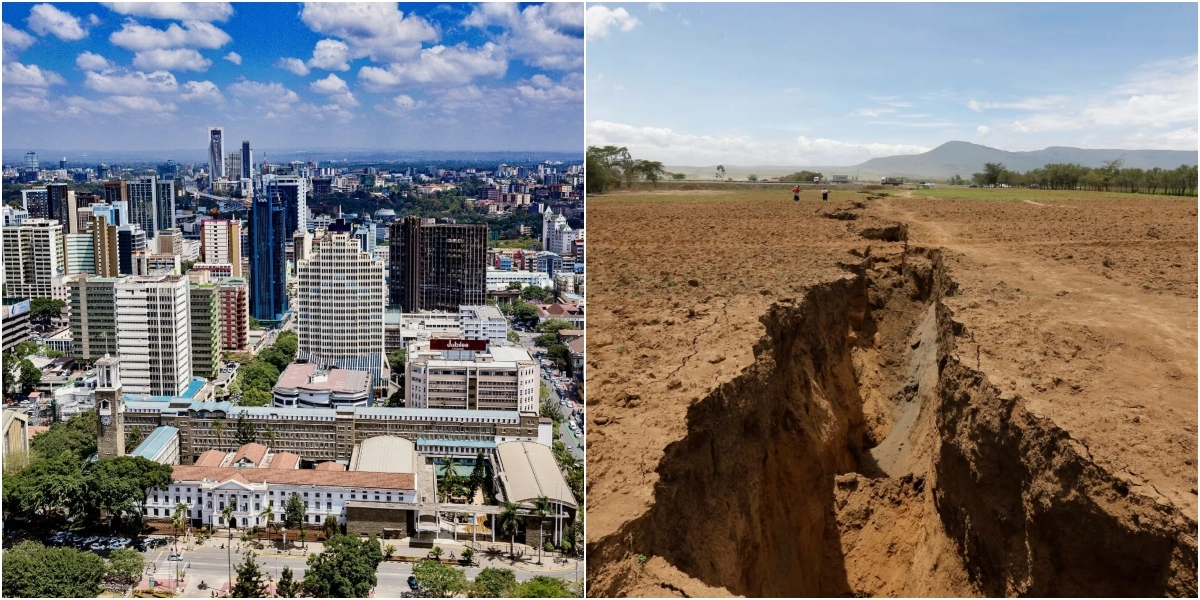A mild earthquake shook Nairobi on Wednesday, June 5, at 1:25 PM, with residents reporting tremors across various parts of the city.
As of Wednesday evening, no national or international seismological agency had confirmed the reports of the earth tremor. The nearest verified earth movement to Kenya was a 5.1 magnitude earthquake in Huíla, Angola, according to New Earthquake.
5.1 earthquake, 89 km W of Caconda, Angola. Jun 5 8:42:24 UTC (20m ago, depth 10km). https://t.co/Q8usWtOit4
— Earthquakes (@NewEarthquake) June 5, 2024
This seismic activity, though minor, draws attention to a much larger and more profound geological phenomenon—the gradual splitting of the African continent along the East African Rift Zone.
This process has been ongoing for millions of years. In East Africa, the Nubian and Somali plates are separating at a rate of 0.2 to 0.5 inches per year, while the Arabian Plate is moving away from Africa at about an inch per year.
National Geographic
This rifting process, which could eventually create a new ocean, carries significant implications for the future of the region.
The Reality of Africa’s Splitting Plates
The East African Rift, a major tectonic plate boundary, stretches from the Afar region in Ethiopia down to Mozambique. It is a place where the African continent is slowly being torn apart. The rift first made headlines in 2005 when a 56-kilometre-long crack appeared in the Ethiopian desert, suggesting that the African continent is undergoing significant geological changes. According to a study published in the Geophysical Research Letters, this process could eventually lead to the creation of a new ocean.
The Formation of a New Ocean
Scientists predict that as the Somali and Nubian tectonic plates continue to pull apart, the Red Sea and the Gulf of Aden will flood into the rift, forming a new ocean. This process, however, will take millions of years. When it is completed, landlocked countries like Uganda and Zambia could find themselves with new coastlines. Christopher Moore, a doctoral student at the University of Leeds, suggests that the entire process could take between five to ten million years.
Consequences and Opportunities
While the formation of a new ocean might seem exciting, it comes with significant consequences. The rifting process will likely result in the displacement of communities and potentially loss of life. Countries in the region will face new challenges as they adapt to these geological changes. However, new coastlines could also unlock economic opportunities, such as new ports for trade, fishing grounds, and sub-sea internet infrastructure, which could transform the economic landscape of these regions.
The Science of Rifting
Rifting occurs when tectonic forces cause a single plate to split into two or more plates, creating a rift valley. This process has been ongoing for millions of years. In East Africa, the Nubian and Somali plates are separating at a rate of 0.2 to 0.5 inches per year, while the Arabian Plate is moving away from Africa at about an inch per year. This slow but persistent movement will eventually lead to significant changes in the continent’s geography.
Historical Context and Future Implications
The concept of continental drift and rifting is not new. Approximately 138 million years ago, similar processes separated South America from Africa, forming the Atlantic Ocean. Today, the East African Rift is undergoing a similar transformation. The gradual separation of the plates will eventually create a smaller continent comprising parts of present-day Somalia, Kenya, Ethiopia, and Tanzania.
Human and Climate Change
The ongoing rifting in East Africa is not just a geological curiosity; it has real-world implications. Africa is already the most impacted region by displacement, with millions of people affected.
As the plates continue to split, more communities will be displaced, and ecosystems will be disrupted. Rapid urbanization, environmental degradation, and habitat changes will pose significant challenges. However, understanding and monitoring these changes can help mitigate some of the negative impacts.
Although the tremor was minor and no significant damage was reported, it highlights the ongoing tectonic activity in the region. While today’s event is a small part of a much larger process, it underscores the importance of being prepared for more significant geological changes in the future.






























